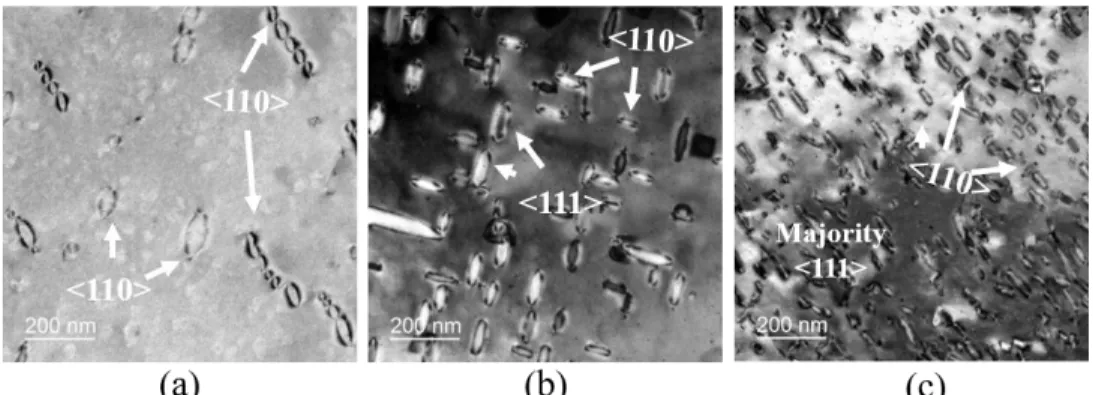HAL Id: cea-02338563
https://hal-cea.archives-ouvertes.fr/cea-02338563
Submitted on 24 Feb 2020HAL is a multi-disciplinary open access archive for the deposit and dissemination of sci-entific research documents, whether they are pub-lished or not. The documents may come from teaching and research institutions in France or abroad, or from public or private research centers.
L’archive ouverte pluridisciplinaire HAL, est destinée au dépôt et à la diffusion de documents scientifiques de niveau recherche, publiés ou non, émanant des établissements d’enseignement et de recherche français ou étrangers, des laboratoires publics ou privés.
Irradiation behavior of austenitic binary model alloys
Ni, Ni-Ti and Ni-Cr
K. Ma, C. Flament, A.-H. Puichaud, P. Bonnaillie, A. Morellec, F. Prima, M.
Loyer-Prost
To cite this version:
K. Ma, C. Flament, A.-H. Puichaud, P. Bonnaillie, A. Morellec, et al.. Irradiation behavior of austenitic binary model alloys Ni, Ni-Ti and Ni-Cr. WOTWISI-5 - 5th workshop on TEM with in situ irradiation, Apr 2018, Huddersfield, United Kingdom. �cea-02338563�
Irradiation behavior of austenitic binary model
alloys: Ni, Ni-Ti and Ni-Cr
K. Ma*†‡, C. Flament†, A.-H. Puichaud†, P. Bonnaillie†, A. Morellec†, F. Prima‡ and M. Loyer-Prost†
†DEN-Service de Recherches de Métallurgie Physique, CEA, Université Paris-Saclay, F-91191
Gif-sur-Yvette, France
‡Institut de Recherche de Chimie Paris, CNRS UMR 8247– Chimie ParisTech, 11 rue Pierre et Marie
Curie, Paris, 75005, France
*Corresponding author e-mail: kan.ma@cea.fr
Austenitic stainless steels are foreseen as cladding and structural materials for future generation IV reactors. However, their swelling under irradiation favored by their Face Centered Cubic (FCC) structure limits their lifetime in reactors and therefore the fuel burn-up. Austenitic steel swelling is a complex phenomenon. It starts with an incubation regime with no macroscopic deformation and is followed by a steady state regime where the swelling rate is about 1%/displacement per atom (dpa). The steel composition does not influence the swelling rate in the steady state regime but thermomechanical treatments, major and minor elements, such as chromium (Cr) and titanium (Ti), play a major role on the incubation dose [2-3]. In order to increase the incubation time of austenitic steels, it is utmost important to get a better understanding of the mechanisms involved.
This study focuses on the effect of Ti and Cr on the microstructure evolution of FCC structure on the incubation period during irradiation. Pure nickel and two binary alloys (Ni-0.4wt%Ti and Ni-0.4wt%Cr) were studied as FCC model alloys of austenitic steels. In a first step, the effect of an addition of Ti or Cr on the nature, size and density of dislocation loops was studied with an ex-situ irradiation experiment on JANNuS-Saclay platform. The samples were irradiated at 450 °C with Ni ions up to 0.5 dpa and characterized by Transmission Electron Microscopy (TEM). Microstructures after irradiation are showed in Fig.1. It suggested that Ti and Cr could delay the transition from Frank loops to perfect loops either by increasing the stacking fault energy or by reducing the defect mobility or the dislocation bias. Therefore, in a second step, the influence of Ti and Cr on the dislocation bias and the loop growth was investigated by electron and ion in-situ experiments at 450°C. Electron irradiations were performed on the High Tension TEM of CEA/SRMA and the Ni ion irradiation on JANNuS-Orsay platform. Results will be presented and discussed during the presentation.
Figure 1: Irradiated microstructure of: (a) pure Ni; (b) Ni-0.4Cr; (c) Ni-0.4Ti with <110> noted as perfect loop and <111> as Frank loop.
References
[1] P. Yvon et al. J. N. Eng. Des. 294 (2015) p 161-169
[2] F.A. Garner. Comprehensive Nuclear Materials, (Elsevier, 2012) p 33-95 [3] A. Benkaddour et al. J. Nucl. Mater. 217 (1994) p 118-126
